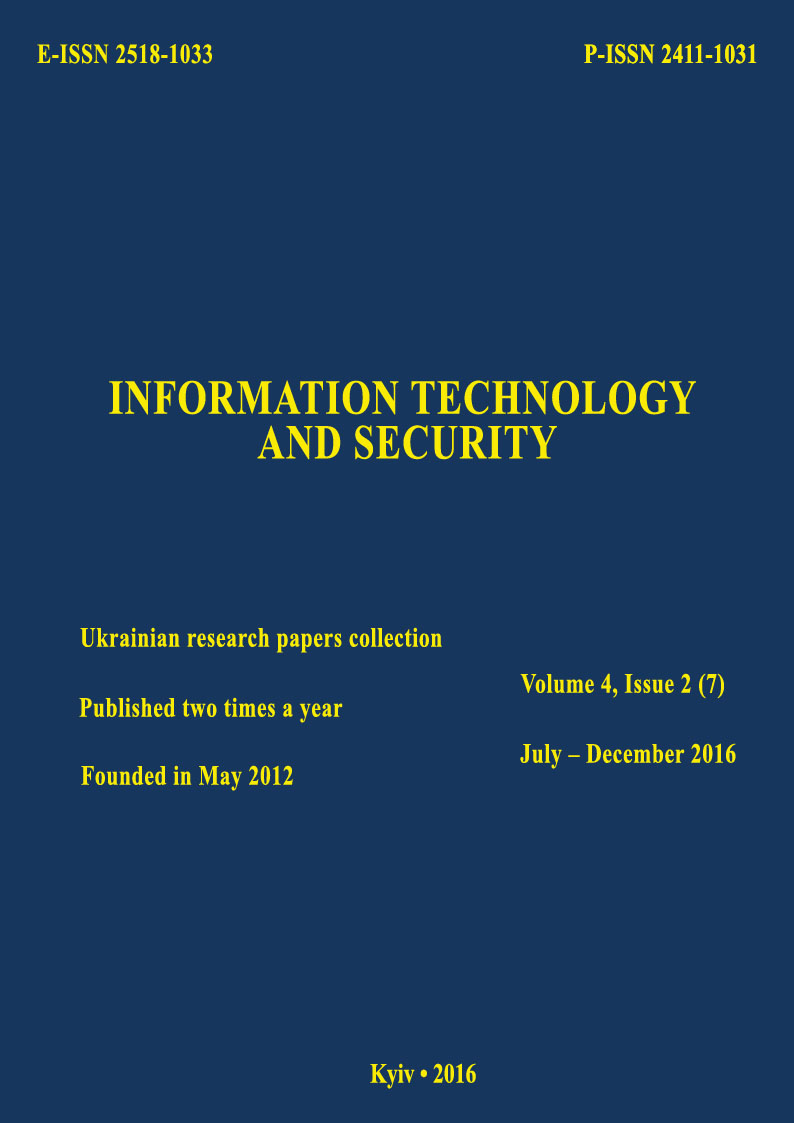Nonlinear properties of agent-based news distribution model
DOI:
https://doi.org/10.20535/2411-1031.2016.4.2.109908Keywords:
News, news distribution, multi-agent model, Hurst index, wavelet-scaling.Abstract
Along with studying common statistic properties of time-series, wavelet-analysis and fractal analysis has been recently used with increased frequency for solving forecasting problems, revealing periodicities, anomalies. The paper deals with Nonlinear (fractal) characteristics (Hurst exponent) and wavelet-scaleograms of the information distribution agent-based model, suggested by the authors. Let us consider an agent-based model with the following performance parameters. Informative messages can be replicated (by way of “reposting”), they can contain links both to informative messages of similar content and to other objects of the real and the virtual world, they can “die” due to ageing etc. The agent’s evolution will be connected with the events, which happened to such agent. As regards to the principal characteristic, let us introduce the “energy”, which reflects the timeliness of the message and the degree of interest to it. It goes without saying, that ageing of information or negative reaction will reduce the message’s energy, and positive reaction or appearance of the link to such message will increase its energy. The authors have studied the effect of Hurst exponent change depending upon the model parameters, which have semantic meaning. The paper also considers fractal characteristics of real information streams. It describes how the Hurst exponent dynamics depends on these information streams state in practice. The authors have suggested an approach to modeling and further forecast of real information streams by changing the model parameters during its operation. With the help of the model and case-studies it has been shown, that it is possible to reveal changes in behavior of real information streams by analyzing changes in the dynamics of Hurst exponent. The diagram of Hurst exponent dynamics has been compared with the wavelet-scaleogram. A more effective algorithm of Hurst exponent evaluation permits recommending constant observation over this parameter dynamics in course of analytical work. Besides, it allows forecasting the information streams’ behavior on the grounds of Hurst parameter value.
References
A.G. Dodonov, and D.V. Lande. Vitality of information systems. Kyiv, Ukraine: Naukova dumka, 2011.
S. Bhargava, A. Kumar, and A. Mukherjee, “A stochastic cellular automata model of innovation diffusion”, Technological Forecasting and Social Change, vol. 44, iss. 1, pp. 87-97, August 1993.
doi: 10.1016/0040-1625(93)90008-U.
D.V. Lande, “Model of information diffusion”, Information Technologies and Security. Information Security Management, iss. 10, pp. 51-67, 2007.
D.V. Lande, A.M. Hraivoronska, and B.O. Berezin, “Model of information spread in social networks”, European Journal of Natural History, no. 5, pp. 41-45, 2016.
D.V. Lande, V.A. Dodonov, and T.V. Kovalenko, “Monitoring of network informational resources based on multiagent Approach”, International Journal of Applied and Fundamental Research, no. 5, 2016. [Online]. Available: www.science-sd.com/467-25062. Accessed on: July 19, 2016.
C.K. Chui. An Introduction to Wavelets. San Diego, New York, USA: Academic Press, 1992.
A.A. Davydov, “Wavelet analysis of social processes”, Sociological Studies, iss. 11, pp. 97-103, 2003.
A.A. Davydov. System Sociology. Moscow, Russia: KomKniga, 2006.
J. Feder. Fractals (Physics of Solids and Liquids). New York, USA: Plenum Press, 1988.
A.F.J. Van Raan. “Fractal geometry of information space as represented by co-cocitation clustering”, Scientometrics, vol. 20, iss. 3, pp. 439–449, March 1991.
doi: 10.1007/BF02019764.
D.V. Lande, “Fractal properties of topic-based information streams from Internet”, Data Registration, Storage and Processing, vol. 8, iss. 2, pp. 93-99, 2006.
O.M. Baranovskyi, and A.B. Kachynskyi, “Study of time-dependent behavior of information streams by R/S analysis method”, Information security of person, society and state, no. 2, pp. 54-58, 2013.
Downloads
Published
How to Cite
Issue
Section
License
Copyright (c) 2020 Collection "Information technology and security"

This work is licensed under a Creative Commons Attribution 4.0 International License.
The authors that are published in this collection, agree to the following terms:
- The authors reserve the right to authorship of their work and pass the collection right of first publication this work is licensed under the Creative Commons Attribution License, which allows others to freely distribute the published work with the obligatory reference to the authors of the original work and the first publication of the work in this collection.
- The authors have the right to conclude an agreement on exclusive distribution of the work in the form in which it was published this anthology (for example, to place the work in a digital repository institution or to publish in the structure of the monograph), provided that references to the first publication of the work in this collection.
- Policy of the journal allows and encourages the placement of authors on the Internet (for example, in storage facilities or on personal web sites) the manuscript of the work, prior to the submission of the manuscript to the editor, and during its editorial processing, as it contributes to productive scientific discussion and positive effect on the efficiency and dynamics of citations of published work (see The Effect of Open Access).

